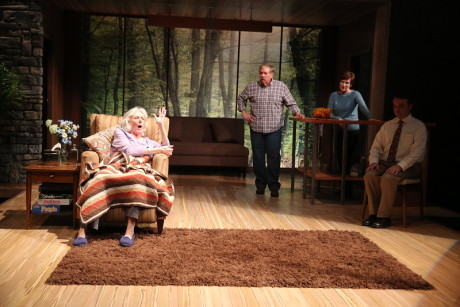Question: What does it take to get an award-winning New York-based actor to perform in a tiny suburban outpost, 20 miles from Washington, DC?
Answer: If the actor is Kathleen Butler—now starring in Marjorie Prime at Olney Theatre Center—all it takes is a great role in “a really good play.”

That’s according to Butler herself, who was interviewed prior to the opening in the Washington Post. And for a woman whose stage career has been closely linked to the plays of Edward Albee, that’s praise indeed for Playwright Jordan Harrison, whose age—he is still in his 30s—makes it hard to believe that he has already written more than a dozen musicals and plays, plus the new Netflex series, Orange is the New Black.
Marjorie Prime is arguably his best yet. A finalist for the 2015 Pulitzer Prize in Drama, this beautifully crafted play is set somewhere in the future, where it is possible to create life-like holograms—actually computer images designed to resemble the departed—that can be programmed to provide company for their survivors.
Called primes—since they are replicas, not originals—Marjorie’s robotic companion is based on the likeness of Walter, her late husband, when he was 30. Played by Michael Glenn, the affable, always-adoring ‘Walter Prime’ can only speak what he’s been programmed to say.
Some of his lines—things like “Eat!” and “Take your pills!”—have been fed to him by Tess, Marjorie’s control-freak of a daughter. Julie-Ann Elliott plays Tess with acidic bitchiness, spewing venom at both her mother and her own (unseen) daughter. It’s a villainous but sad role.
Jon, who is Marjorie’s son-in-law, is performed with gentle strength and patience by Michael Willis, who invests the character with the kind of understanding that only a non-relative—spared the baggage of a painful childhood—can achieve.
It is thanks to Jon that Walter Prime can respond to Marjorie with some of the make-believe memories that make life more palatable and age more fun.
However, it is Marjorie herself –brought to brilliant life by the redoubtable Kathleen Butler—who commands the stage. With a dizzying array of zingers and fluttering gestures, she brings the maddening 85-year-old Marjorie into bloom.
In her happiest moments, Marjorie blossoms, flirting with Walter, embracing Jon and putting down her sharply critical daughter. Her memories—regardless of whether or not they happened—give her life.
In a way, Marjorie Prime is a play about memory. And about false memory, in particular. It is about story-telling in its most basic form, which is often about revising the truth. We all do it, editing out the parts we don’t like and reinventing the past so that it conforms to what we want to believe.
In the beginning of the play, Marjorie remembers that Walter’s marriage proposal came after seeing a forgettable movie. So much better, she thinks, had it been Casablanca. Soon, Casablanca it is! Some memories are improved. Others, such as the death of a child, are denied.
According to the program, part of the inspiration for the play came from the playwright’s experiences watching his grandmother—in some ways a model for Marjorie—as she coped with memory loss. Another source of inspiration came from his online conversations with chatbots, which he conducted in order to learn how computers can be programmed to respond to humans.
The set design by Misha Kachman is extraordinary. The stage of the small black box theatre is turned into a timeless suburban setting, alternating between the interiors of the homes of Marjorie and Tess.
At the rear of the stage, a wall-to-wall window overlooks a garden. The window, made of Plexiglas, creates a mirror-like effect so that Walter—the computer-generated hologram—is reflected in it, reminding us of his virtual reality.
Dimly-lit alcoves, located on either side of the stone walls of the house, provide a screened-in setting for those who are already dead. The lighting and sound design, by Colin K. Bills and Robert Kaplowitz respectively, brilliantly reinforce the passage of time, creating the illusion of change. The use of Vivaldi’s Four Seasons is highly evocative.
Artistic Director Jason Loewith directed Marjorie Prime with his usual power and incisiveness.

Not surprisingly, Marjorie Prime has come a long way in its relatively short life. First produced in 2014 at the Mark Taper Forum in Los Angeles, and just recently at Playwrights Horizons in New York, it has now been adapted into a major film, scheduled to open next year.
But don’t wait. The upcoming film version of Marjorie Prime, no matter how good, can’t possibly rival Olney Theatre Center’s production. What a thrill it is watching this exceptional actor who is still in her prime.
Running Time: 80 minutes, with no intermission.
Marjorie Prime plays through April 10, 2016 in the Mulitz-Gudelsky Theatre Lab at Olney Theatre Center – 2001 Olney Sandy Spring Road, in Olney, MD. For tickets, call the box office at (301) 924-3400, or purchase them online.
RATING:





